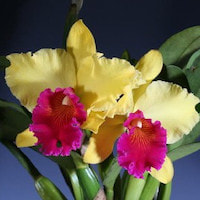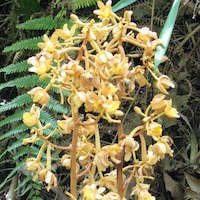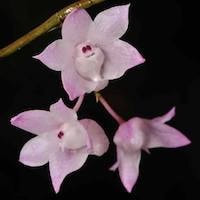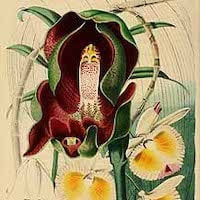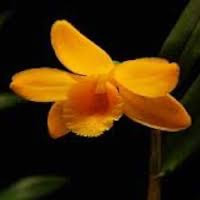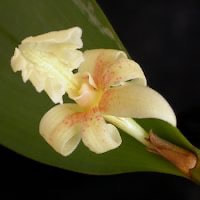Experience Fresh 9 Women Fragrance Oil
Brassolaeliocattleya is a hybrid orchid resulting from a cross between a highly fragrant miniature cattleya and a full-sized lavender. The flowers of this orchid are compact, large, and range in color from deep pink to lavender, featuring a distinctive gold lip.
Cyrtosia septentrionalis, also known as Xue hong rou guo lan in Chinese, is an orchid species that has adapted to self-pollination due to limited insect pollinators. It contains glycosides and phenolic derivatives. In traditional medicine, it is used for treating muscle stiffness, sores, fungal skin infections, and gonorrhea.
Dendrobium aduncum, known by various Chinese names such as Gouzhuangshihu and Huangcaoshihu, is widely distributed in the Himalayan foothills and southern China. It is valued for its ability to promote vitality, benefit the stomach, relieve thirst, and improve appetite.
Dendrobium devonianum, referred to as Chiban Shihu in Chinese, blooms in April or May. It contains compounds with antioxidant activity and is utilized in Nepal for healing boils, pimples, and as a general medicinal plant.
Dendrobium lohohense, also known as Luohe Shihu, contains shihunine, which converts into betaine. This orchid species is used in Chinese medicine for various purposes.
Dendrobium plicatile, also called Jibai, Jibanti, or Jivanti in Indian names, contains alkaloids, phenanthrenes, and compounds with antioxidant properties. In Ayurvedic medicine, it is used to address ailments related to bile, blood, and phlegm disorders.
In addition to these orchid notes, the fragrance formulation also includes other scent notes such as Ivy, Tobacco leaf, Lemongrass, Eucalyptus, Sage, Vine, Tobacco, Ginkgo, Violet leaf, Juniper, and Wintergreen.
Cyrtosia septentrionalis, also known as Xue hong rou guo lan in Chinese, is an orchid species that has adapted to self-pollination due to limited insect pollinators. It contains glycosides and phenolic derivatives. In traditional medicine, it is used for treating muscle stiffness, sores, fungal skin infections, and gonorrhea.
Dendrobium aduncum, known by various Chinese names such as Gouzhuangshihu and Huangcaoshihu, is widely distributed in the Himalayan foothills and southern China. It is valued for its ability to promote vitality, benefit the stomach, relieve thirst, and improve appetite.
Dendrobium devonianum, referred to as Chiban Shihu in Chinese, blooms in April or May. It contains compounds with antioxidant activity and is utilized in Nepal for healing boils, pimples, and as a general medicinal plant.
Dendrobium lohohense, also known as Luohe Shihu, contains shihunine, which converts into betaine. This orchid species is used in Chinese medicine for various purposes.
Dendrobium plicatile, also called Jibai, Jibanti, or Jivanti in Indian names, contains alkaloids, phenanthrenes, and compounds with antioxidant properties. In Ayurvedic medicine, it is used to address ailments related to bile, blood, and phlegm disorders.
In addition to these orchid notes, the fragrance formulation also includes other scent notes such as Ivy, Tobacco leaf, Lemongrass, Eucalyptus, Sage, Vine, Tobacco, Ginkgo, Violet leaf, Juniper, and Wintergreen.
Download the guided mediation that works best with this Orchid fragrance oil
| women_fresh_essential_oil_orchi_00009.mp3 | |
| File Size: | 4033 kb |
| File Type: | mp3 |
Rediscover Your Inner Balance
Contains Scented Notes of following in various proportions:
Native Singaporean Orchid notes: Brassolaeliocattleya
|
Brassolaeliocattleya - Used in Fresh 9 (Women) for Team building Perfume workshop
Brassolaeliocattleya is an exquisite orchid hybrid that combines the best characteristics of a highly fragrant miniature cattleya and a full-sized lavender. Through careful breeding and cultivation, this hybrid has emerged as a captivating and sought-after orchid variety. The flowers of Brassolaeliocattleya are a testament to its beauty. When it first blooms, it presents a spectacular display of compact, yet generously sized, blossoms. These flowers exhibit a stunning color range, ranging from deep pink to soothing lavender hues. One cannot help but be captivated by the mesmerizing shades that adorn each delicate petal. Adding to its allure, Brassolaeliocattleya boasts a distinctive feature—a lip adorned with a golden hue. This golden lip serves as a focal point, drawing attention and enhancing the overall aesthetic appeal of the orchid. It creates a mesmerizing contrast against the backdrop of the flower's vibrant colors, adding a touch of elegance and sophistication. With its impressive fragrance and breathtaking appearance, Brassolaeliocattleya is a true gem among orchid enthusiasts. Its ability to combine the intoxicating scent of a miniature cattleya with the grace and charm of a lavender creates a unique olfactory experience. Each bloom is a testament to the artistry and dedication of orchid hybridizers, resulting in a floral masterpiece that continues to captivate and delight all who encounter it. |
Therapeutic Orchid notes:
|
Cyrtosia septentrionalis (Rchb. f.) Garay
Syn. Galeola septentrionalis Rchb. f. Chinese name: Xue hong rou guo lan Chinese medicinal name: Shanshanhu Japanese name: Tsuchi-akebi, Dutuusoo Cyrtosia septentrionalis, also known as Galeola septentrionalis, is an orchid species that thrives in the shaded and sparse understory of forests. Due to the limited presence of insect pollinators in its habitat, this orchid has developed an effective self-pollinating system as an adaptation for reproduction. The phytochemical profile of Cyrtosia septentrionalis reveals the presence of several glycosides and eight phenolic derivatives. These bioactive compounds include 2,4-bis(4-hydroxybenzyl) phenol, Bis4(beta-D-glucopyranosyloxy)-benzyl-(-)-2-isopropylmalate, Bis4-(beta-D-glucopyranosyloxy)benzyl-(-)-2-sec-butylmalate, 4-hydroxybenzylaldehyde, 4,40-dihydroxydiphenyl-methane, 4-hydroxybenzylalcohol, 4-(beta-D-glucopyranosyloxy)benzyl alcohol (also known as gastrodin), and 5-methoxy-3-(2-[phenyl-E-ethenyl)-2,4-bis(4-hydroxybenzyl)phenol. In traditional herbal medicine, Cyrtosia septentrionalis is used for its therapeutic properties. It is commonly employed in the treatment of muscle stiffness or spasms. A paste made from the whole plant mixed with vegetable oil is applied topically to alleviate symptoms of sores and fungal infections with ulceration. Additionally, the fruit of Cyrtosia septentrionalis, when prepared in a decoction with licorice, is utilized for treating gonorrhea. In Japan, the decoction of the root of Galeola septentrionalis was historically used for the treatment of gonorrhea. Furthermore, the ash obtained from burning the plant was employed as a hair tonic to address scalp diseases. |
|
Dendrobium aduncum Lindl. Syn D. scorianum W. W. Smith, D. faulhaberianum Schltr.
Chinese names: Gouzhuangshihu (noble hook Dendrobium), Huangcaoshihu (yellow herbal Dendrobium); Dahuangcao (large yellow herbal Dendrobium); Honglancao (red orchid herb); Jishengcao (parasitic herb) Dendrobium aduncum, also known as Dendrobium scorianum and Dendrobium faulhaberianum, is a species of orchid with various Chinese names such as Gouzhuangshihu (noble hook Dendrobium), Huangcaoshihu (yellow herbal Dendrobium), Dahuangcao (large yellow herbal Dendrobium), Honglancao (red orchid herb), and Jishengcao (parasitic herb). It has a wide distribution, ranging from the Himalayan foothills to Kwangtung Province, Hong Kong, Lantau, and Hainan Islands in southern China. It can also be found in Myanmar, northern Thailand, and Vietnam. In traditional herbal usage, Dendrobium aduncum is known as Shihu. The stem of this orchid is highly valued for its nourishing properties and its ability to promote vitality. It is considered antipyretic, helping to reduce fever, and it also benefits the stomach and alleviates thirst. This orchid is commonly used to support individuals who are weak due to illness or have a poor appetite, providing them with nourishment and support for overall well-being. Its traditional usage highlights its potential as a natural remedy for enhancing vitality and addressing various health concerns. |
|
Dendrobium devonianum Paxton D. pulchellum Lindl.
Chinese name: Chiban Shihu (teeth pedal Dendrobium) Thai names: Miang; Ueang sai man pra in, Ueang sai pha kang, Ueang sai luat Dendrobium devonianum, also known as Dendrobium pulchellum, is a species of orchid with the Chinese name Chiban Shihu, which translates to "teeth pedal Dendrobium." In Thailand, it is known by the names Miang, Ueang sai man pra in, Ueang sai pha kang, and Ueang sai luat. This orchid produces flowers that typically bloom in April or May and have a lifespan of approximately two weeks. In terms of phytochemistry, studies have identified several compounds present in Dendrobium devonianum, including two compounds that exhibit antioxidant activity. Additionally, the orchid contains a unique flavonol glycoside known as 5-hydroxy-3-methoxy-flavone-7-O-[beta-D-apiosyl-(1-6)]-beta-D-glucoside. These compounds contribute to the orchid's chemical composition and may have potential health benefits. In traditional herbal usage, Dendrobium devonianum is used similarly to other Shihu orchids. In Nepal, the pulp of the pseudobulb is applied topically to boils and pimples to promote healing. The specific application of this orchid in traditional medicine highlights its potential for its healing properties and suggests its traditional usage as a natural remedy for skin conditions. |
|
Dendrobium lohohense Tang & F.T.Wang
Chinese name: Luohe Shihu (Luo River Dendrobium) Japanese herbal name: Chukanso Dendrobium lohohense, commonly known as Luohe Shihu or Luo River Dendrobium, is an orchid species. It is also referred to as Chukanso in Japanese herbal medicine. This orchid contains a compound called shihunine, which is utilized by shamans in the Amazonian Basin as part of their rituals. Shihunine has the unique property of rapidly and almost completely converting into betaine. Betaine is a compound commonly found in dietary supplements and is sometimes prescribed by physicians, along with vitamins B6, B12, and folic acid, for individuals with elevated levels of homocysteine in their blood. High homocysteine levels are associated with an increased risk of coronary heart disease and stroke. However, it is important to note that consuming Dendrobium lohohense or its shihunine content does not guarantee prevention or treatment of cardiovascular disease. In traditional Chinese medicine, Dendrobium lohohense is collected and used as shihu. Shihu is a general term used for various Dendrobium species in Chinese herbal medicine. While the specific herbal usage of Dendrobium lohohense may vary, it is recognized as a valuable plant within traditional Chinese medicine. |
|
Dendrobium plicatile Lindl. syn. Flickingeria fimbriata (Blume) A.D. Hawkes; Dendrobium macraei Lindl.,
Dendrobium plicatile, also known as Flickingeria fimbriata or Dendrobium macraei, is a species of orchid that has various names across different cultures and regions. In India, it is known as Jibai, Jibanti, Jivanti, Radarudi, Wajhanti, and several other names in different languages. In Ayurvedic medicine, it is referred to as Jeewanti in the Sarangadhara Sanghita. In Sri Lanka, it is called Jata makuta. In China, it is known as Liusu Jin Shihu or Tassels gold Dendrobium, and its Chinese medicinal name is Youguashihu. Dendrobium plicatile is a unique orchid with long, branching pseudobulbs and creeping rhizomes. It bears small, insignificant white flowers that last only for a day. Despite its unremarkable appearance, the plant holds medicinal value. Phytochemical analysis has revealed that Dendrobium plicatile contains alkaloids, phenanthrenes, lusianthrin, erianthridin, ephemernthroquinone, and a dimethoxydihydrophenanthrene compound related to nudol. These compounds have shown various activities, including high cytotoxicity, smooth muscle relaxation in the intestine and blood vessels, and anti-coagulant properties. Many of the compounds also exhibit antioxidant activity. In traditional herbal usage, Sanskrit writers have described Dendrobium plicatile as having a cooling, mucilaginous, and light nature. It is considered a tonic and is used to address disorders related to bile, blood, and phlegm. It is often prepared as a decoction with other plants that possess similar properties. Additionally, the fruit of this orchid is regarded as an aphrodisiac. In Rasayana therapy, it is utilized, and in West Bengal, it is sold as Jibanti. Historically, Dendrobium plicatile has been mentioned as a constituent of local remedies for snake and scorpion bites in Sushruta, an ancient Indian text on medicine. However, the efficacy of this use is uncertain. In Sri Lanka, ancient writers have regarded the orchid as Jeevaniya, meaning "supporting life," and saaka shreshtha, meaning "best of herbs," highlighting its esteemed status in traditional practices. |
Other scent note
Ivy, Tobacco leaf, Lemongrass, Eucalyptus, Sage, Vine, Tobacco, Ginkgo, Violet leaf, Juniper, Wintergreen
Scentopia Library Reference ingredient
Fir - Check details at Scentopia's scent library
Join Scentopia's wonderful orchid scent crafting, fragrance tour, bridal shower or corporate team building which includes perfume making onsite and offsite, beach activities and more. We also serve primary school learning journey, secondary students and pupil on industrial excursions. Know more about our orchids perfume bar or therapeutic orchid scents and other wellness aromas. Conatct Perfume workshop or book a scent crafting session here.
